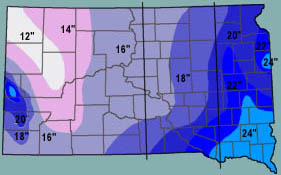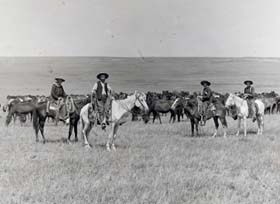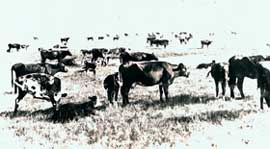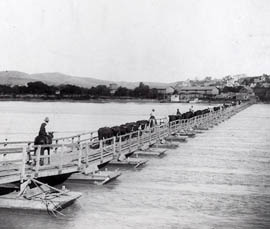|
Lesson 3
The Open Range and New Land Openings
|
| |
Another pocket of open land in South
Dakota was the western strip. It had been opened to settlement in
1877. This was the Black Hills and the range land north and south of
the hills. Settlers came here, too, although not by railroad at
first. Homesteaders soon found that this land was better suited to
ranching. The main reason had to do with rainfall.
|
|
Different parts of South Dakota get
different amounts of
moisture each year. Eastern South Dakota gets
the most. As you go west from Sioux Falls, less and less rain or
snow falls. The Black Hills are like an island. They get as much
rain and snow as the eastern part of the state. But north and south
of the hills, very little rain falls each year. That means that
plants that need a lot of water will not grow well there. Wheat and
corn do not do well. But cattle and sheep do quite well. They eat
the grasses and grow fat.
|

Rainfall Map
|
|

Photo courtesy of South Dakota State
Historical Society
|
Ranchers moved into western Dakota just
after the gold rush of 1876. They grew beef for the Black Hills
prospectors to eat. Soon big cattle outfits from Texas ran herds on
the unfenced pastures of western Dakota. This was called the open
range. Cowboys branded the cattle to keep track of their own
animals. Cowboys would drive the cattle north from Texas to fatten
them up. Then they would drive them back south to the railroads in
Nebraska and Kansas. The big herds did well until the winter of
1886-1887. This hard winter killed thousands of cattle. It was the
end of the open range.
|
|
Railroads now began to move into the
Black Hills. The Fremont, Elkhorn & Missouri Valley Railroad
came up from Nebraska. It reached Rapid City in 1886. Soon Rapid
City was a thriving town full of businesses. The railroads helped
mining to grow as well. They brought supplies to the mines. Then
they took gold to eastern markets. By 1890, Lead was the second
largest city in South Dakota. It was the home of the Homestake
Mining Company.
|

Photo courtesy of South Dakota State
Historical Society
|
|

Photo courtesy of South Dakota State
Historical Society
|
In 1889, South Dakota became a state.
The following year, parts of the Great Sioux Reservation were opened
to settlers. The Lakotas now had six smaller reservations (you read
about this in Unit 5). Homesteaders began to cross the Missouri
River. They took claims on the central and northwestern plains. Here
they learned what the Lakotas found out on their 160-acre plots. The
land was not well suited to farming. New crops such as alfalfa and
winter wheat would grow here. But cattle and sheep still did the
best. Small ranches dotted the plains.
|
|
Again, the United States government
opened more land on the reservations. These lands had not been
allotted to Lakota men or women. From 1904 to 1911, thousands of
acres were opened in land
lotteries. All were west of the Missouri
River. Homesteaders poured into the state to sign up for the
drawings. But their chances of winning were not good. There were far
more people than there were claims. That is why the government set
up the lotteries. In the first one, there were about twenty-five
hundred homesteads. Over one hundred thousand people signed up for
them. After a person won the right to stake a claim, he or she raced
across the land to find the best spot.
|
.gif)
Reservation Lands Map
|
|

Photo courtesy of South Dakota State
Historical Society
|
More and more people began ranching. But
getting cattle from western South Dakota to eastern markets was not
easy. Some ranchers drove their cattle to Pierre and Chamberlain.
There they crossed the Missouri River. They used
ferries or
pontoon bridges. Then they loaded their cattle onto trains. Not until 1907
would railroad bridges span the Missouri River. One was at Pierre
and one at Mobridge. At long last, railroads crossed the entire
state, from east to west. Dozens of new towns were born—Murdo,
Kadoka, Wall, Faith, Dupree, Lemmon, and more.
|
|
|
|
| Vocabulary |
|
| ferries (n.), boats that carry things across a body of
water
lotteries (n.), activities in which numbered tickets are
sold and drawings decide the winner
|
moisture (n.), liquid; water
pontoon bridges (n.),
floating bridges
|
|
|